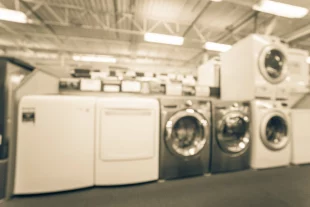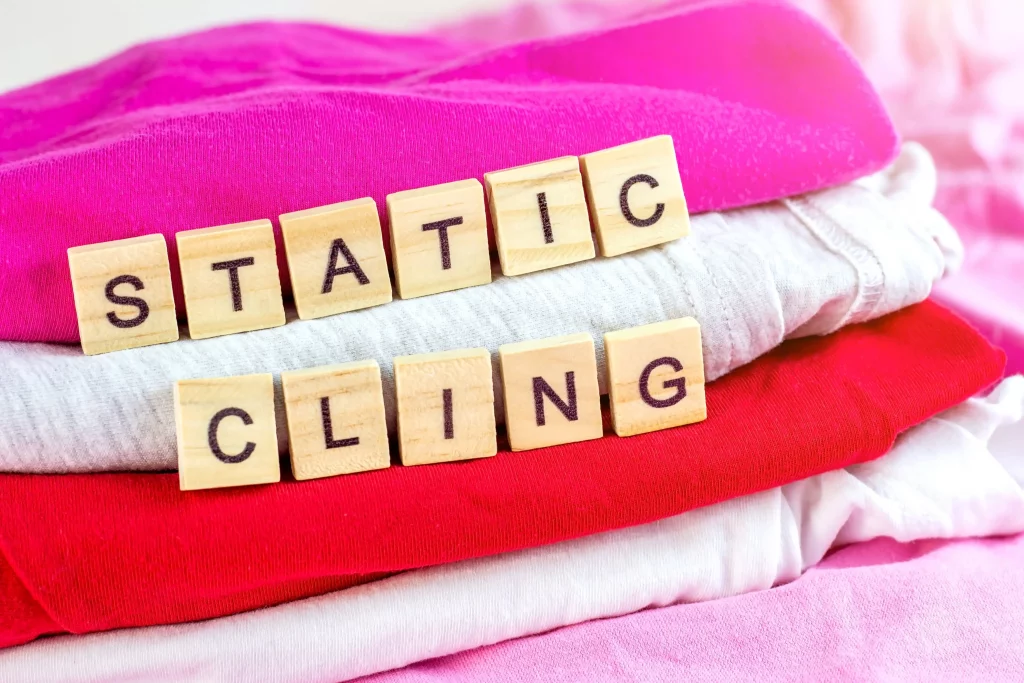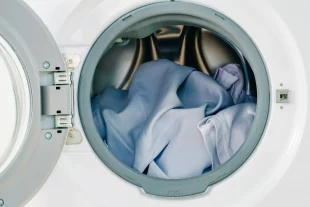 Get Garment Guides
Get Garment Guides
Gas vs Electric Dryer
🗽Break free from hidden pricing. Discover transparency in our Savings Calculator!
Read tips, tricks, and how-to’s on our Fabric of Life blog.🎆
How-To's

To get rid of static cling on clothes, you can use quick fixes like dryer sheets or wool dryer balls, and prevent static buildup by adjusting your laundry habits.
One of the most frustrating parts of laundry is pulling it freshly from the dryer, only to find that your clothes are clinging together due to static electricity. The good news is there are several ways to minimize static cling and eliminate it altogether.
Static cling is the result of electrostatic charges occurring between fabrics. The combination of heat and friction inside a dryer causes clothing to accumulate a lot of electrical charge. Here are a few other reasons for static on clothing.
One of the most common and most effective ways to reduce static cling is to incorporate dryer sheets or a fabric softener sheet into your laundry routine. This simple practice can freshen your clothing and help avoid clinging. The sheets work as they are coated in fabric softeners that carry positive chargers. These charges counteract static creating negative electrons, and preventing static build-up.
Wool dryer balls are another safe option to reduce static electricity when drying your laundry. These balls of wool absorb the moisture of your wet laundry. Towards the end of the cycle, the balls will release some of the moisture back into the clothing, creating the ideal environment to avoid static cling by balancing positive and negative charge.
Pro tip: You can add a few drops of your favorite essential oils to your wool balls to increase fragrance and further freshen clothing.
When your garments stick together, try using aluminum foil balls can make a significant difference. Simply take pieces of aluminum foil, ball it up until it is about 2-3 inches thick, and toss it into your dryer with your wet clothing. This technique can drastically reduce static between clothes because the metal discharges the electricity, minimizing build-up.
Additional Tip: If you do not have any aluminum foil, attaching a safety pin or two to a towel while your clothing is drying, can have the same effects.
Investing in an anti-static spray designed to be a static guard for clothing can be a game-changer during the drying cycle. These sprays are formulated to rebalance the electrons and their charges between garments while they dry.
You can either purchase this in store, or make this spray at home on your own with just 3 ingredients. Begin by mixing one cup of water with 2 tablespoons of liquid fabric softener and 2 tablespoons of vinegar. Once your clothing is dry, you can lightly coat this on your clothing using a spray bottle and toss it back into the dryer on no heat. This is an effective static discharge method that works quickly.
If you really want to avoid static cling all altogether, your best bet is to switch to a more practical approach: air-drying your laundry after the wash cycle. With air-drying, you eliminate friction, which is the worst culprit for static cling. With this technique, you can choose to dry indoors or outdoors, weather permitting. For those who want to fully embrace this alternative drying method should consider, consider investing in a high-quality clothesline or drying rack.
Additional Tip: If air-drying takes too long after and you are in a pinch, put your clothing into a tumble dryer on low heat after the rinse cycle to lessen static.
Regardless of the fabric type, using proper ironing techniques plays a significant role in preventing static in clothing. When ironing is necessary, it’s best to use a low-temperature setting to reduce the risk of static cling.
To further protect your clothes, you can place a cloth barrier between the iron and the garments. This simple yet effective step helps shield your clothes from excessive heat, promoting their longevity and preserving their quality. Refined ironing not only helps prevent static but also maintains the overall condition of your wardrobe.
One way to avoid static build-up in your laundry room is to control and balance the humidity levels. In periods of dry air, i.e the winter months, the humidity levels drop. When humidity is low, static electricity is more likely. During these times, adding a humidifier to your laundry room can make a significant difference. Strive to sustain indoor humidity between 30 and 40 percent, creating an environment less prone to electric charges.
Remember that static-free clothing depends not only on the fabric and what goes on in the washing machine, but also on how you store your garments. Using smart storage practices, especially for delicate fabrics, is important. You may want to consider using breathable garment bags to protect your clothes while still allowing them to breathe.
It’s also important to avoid hanging clothes for long periods, as this can cause irreversible stretching. Therefore, prioritize storage methods that maintain the original form items to also retain their quality.
Static cling is common, and while there are many DIY methods you can use to manage it better at home, finding a solution that works all the time is a challenge. Home remedies like dryer sheets, vinegar rinses, or wool dryer balls work most of the time but can damage your clothing when used time and time again.
If you need a way to reduce static and the resulting wrinkles and discomfort, it might be better to consider a more reliable solution, professional cleaners can apply proven methods that use high-quality products.
CD One Price Cleaners offers exceptional laundry services that go beyond simple cleaning. We ensure your clothes are treated with care. Using advanced cleaning techniques, we consider the unique needs of each fabric, applying anti-static treatments that keep your garments soft, fresh, and static-free. Whether you’re dealing with delicate fabrics or large, everyday loads, our professional methods provide long-lasting protection against static build-up while preserving the quality and comfort of your clothing.
Contact CD One Price Cleaners or visit our website today and learn more about our comprehensive laundry solution. Take the load off your shoulders and hand it over to us. Our team is ready to assist you with all your laundry needs!
We think you may like
 Get Garment Guides
Get Garment Guides
Gas vs Electric Dryer
 Get How-To's
Get How-To's
How to Iron
 Get How-To's
Get How-To's
How to Wash Silk